

GUYS READ. Literature » Grade 3. What Parents Should Know. Today’s students are preparing to enter a world in which colleges and businesses are demanding more than ever before.
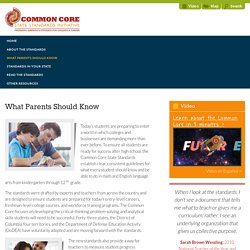
To ensure all students are ready for success after high school, the Common Core State Standards establish clear, consistent guidelines for what every student should know and be able to do in math and English language arts from kindergarten through 12th grade. The standards were drafted by experts and teachers from across the country and are designed to ensure students are prepared for today’s entry-level careers, freshman-level college courses, and workforce training programs. The Common Core focuses on developing the critical-thinking, problem-solving, and analytical skills students will need to be successful. Forty-three states, the District of Columbia, four territories, and the Department of Defense Education Activity (DoDEA) have voluntarily adopted and are moving forward with the standards. Key Shifts in English Language Arts. The Common Core State Standards for English Language Arts and Literacy build on the best of existing standards and reflect the skills and knowledge students will need to succeed in college, career, and life.
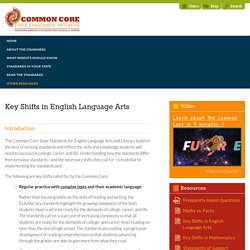
Understanding how the standards differ from previous standards—and the necessary shifts they call for—is essential to implementing the standards well. Key Shifts in Mathematics. The Common Core State Standards for Mathematics build on the best of existing standards and reflect the skills and knowledge students will need to succeed in college, career, and life.
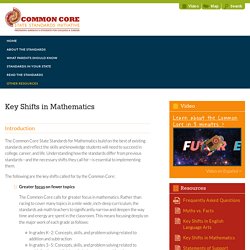
Understanding how the standards differ from previous standards—and the necessary shifts they call for—is essential to implementing them. The following are the key shifts called for by the Common Core: Greater focus on fewer topicsThe Common Core calls for greater focus in mathematics. Rather than racing to cover many topics in a mile-wide, inch-deep curriculum, the standards ask math teachers to significantly narrow and deepen the way time and energy are spent in the classroom. Grade 3 » Introduction. In Grade 3, instructional time should focus on four critical areas: (1) developing understanding of multiplication and division and strategies for multiplication and division within 100; (2) developing understanding of fractions, especially unit fractions (fractions with numerator 1); (3) developing understanding of the structure of rectangular arrays and of area; and (4) describing and analyzing two-dimensional shapes.
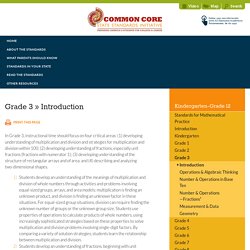
Students develop an understanding of the meanings of multiplication and division of whole numbers through activities and problems involving equal-sized groups, arrays, and area models; multiplication is finding an unknown product, and division is finding an unknown factor in these situations. For equal-sized group situations, division can require finding the unknown number of groups or the unknown group size.
Start with a Book. What is fluency?

Why does it matter? Reading fluency is a child's ability to read a book or other text correctly, quickly, and with expression. A fluent reader doesn't have to stop and "decode" each word. Rather, most of the words can be read automatically. This means the reader can focus his attention on what the story or text means. How fluent is your child? Fluency develops over time and with lots of practice. Age-Appropriate Chores for Children (and Why They're Not Doing Them) Photo This Montessori chart of “Age-Appropriate Chores for Children” is making the Facebook rounds.

(The shares on my page came from the Facebook page of “Maria Montessori.”) With it, the commentary. Apparently, a lot of “other parents” have complained about this list. Those “other parents” say things like “children aren’t slaves” and “carrying firewood is dangerous!” But we, the parents in the know who share this chart and comment with the greatest enthusiasm — our children are doing these things. Well, maybe yours do. Parenting Tips To Teach Children Emotional Resilience. By Justin Coulson | The school years present children with countless challenges, setbacks, failures, and general difficulties.
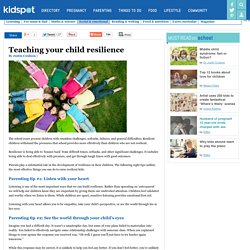
Resilient children withstand the pressures that school provides more effectively than children who are not resilient. Resilience is being able to ‘bounce back’ from difficult times, setbacks, and other significant challenges. It includes being able to deal effectively with pressure, and get through tough times with good outcomes. Parents play a substantial role in the development of resilience in their children. Parenting tip #1: Listen with your heart Listening is one of the most important ways that we can build resilience.
Listening with your heart allows you to be empathic, take your child’s perspective, or see the world through his or her eyes. MindSet: A Book written by Carol Dweck. Teaching a growth mindset creates motivation and productivity in the worlds of business, education, and sports. How to Talk So Kids Will Listen & Listen So Kids Will Talk: Adele Faber, Elaine Mazlish: 9781451663884: Amazon.com: Books. Parenting Archives - LearningWorks for Kids. Executive Function Skills at Home. The Read-Aloud Handbook: Seventh Edition (9780143121602): Jim Trelease: Books. The Blessing of a B Minus: Using Jewish Teachings to Raise Resilient Teenagers: Wendy Mogel Ph.D.: 9781416542049: Amazon.com: Books.
Parent Roadmaps to Common Core Standards / Parent Roadmaps- Mathematics. More Resources for Educators and Parents. Responsive Classroom Information. Raising Your Spirited Child: A Guide for Parents Whose Child Is More Intense, Sensitive, Perceptive, Persistent, and Energetic: Mary Sheedy Kurcinka: 9780060739669: Amazon.com: Books. Parenting the Spirited Child. 1-2-3 Magic Parenting.